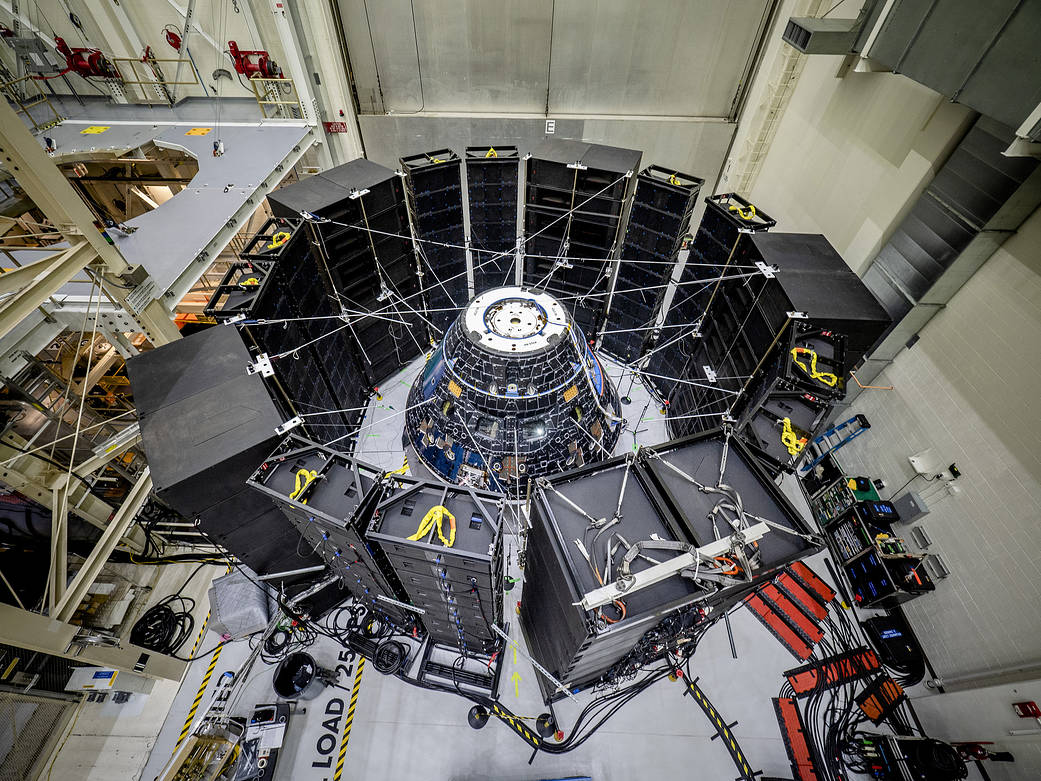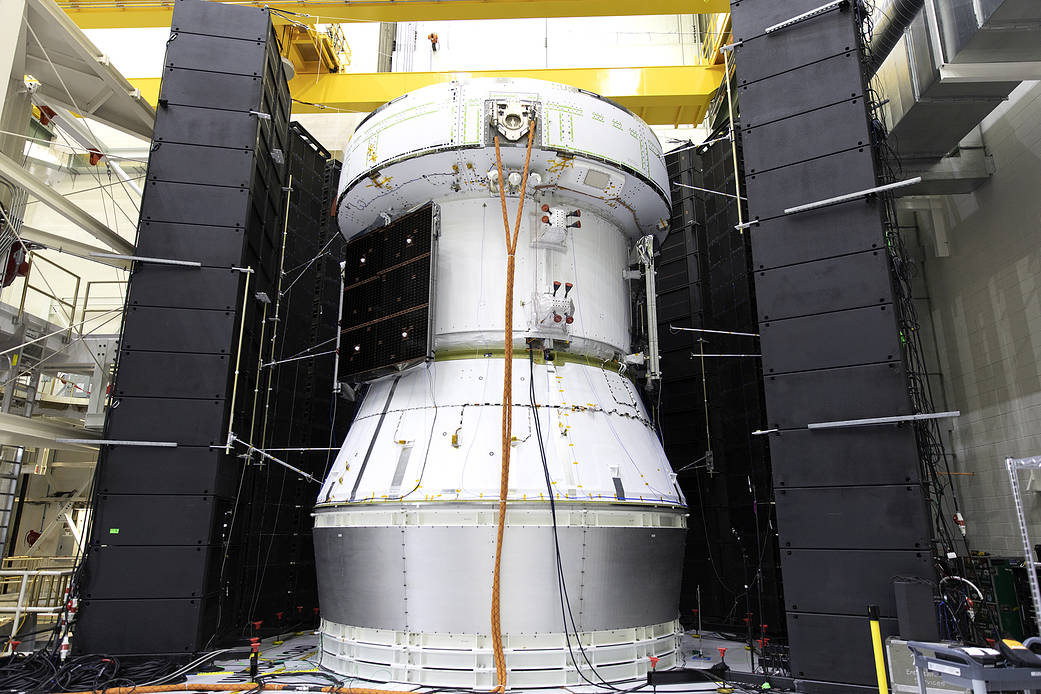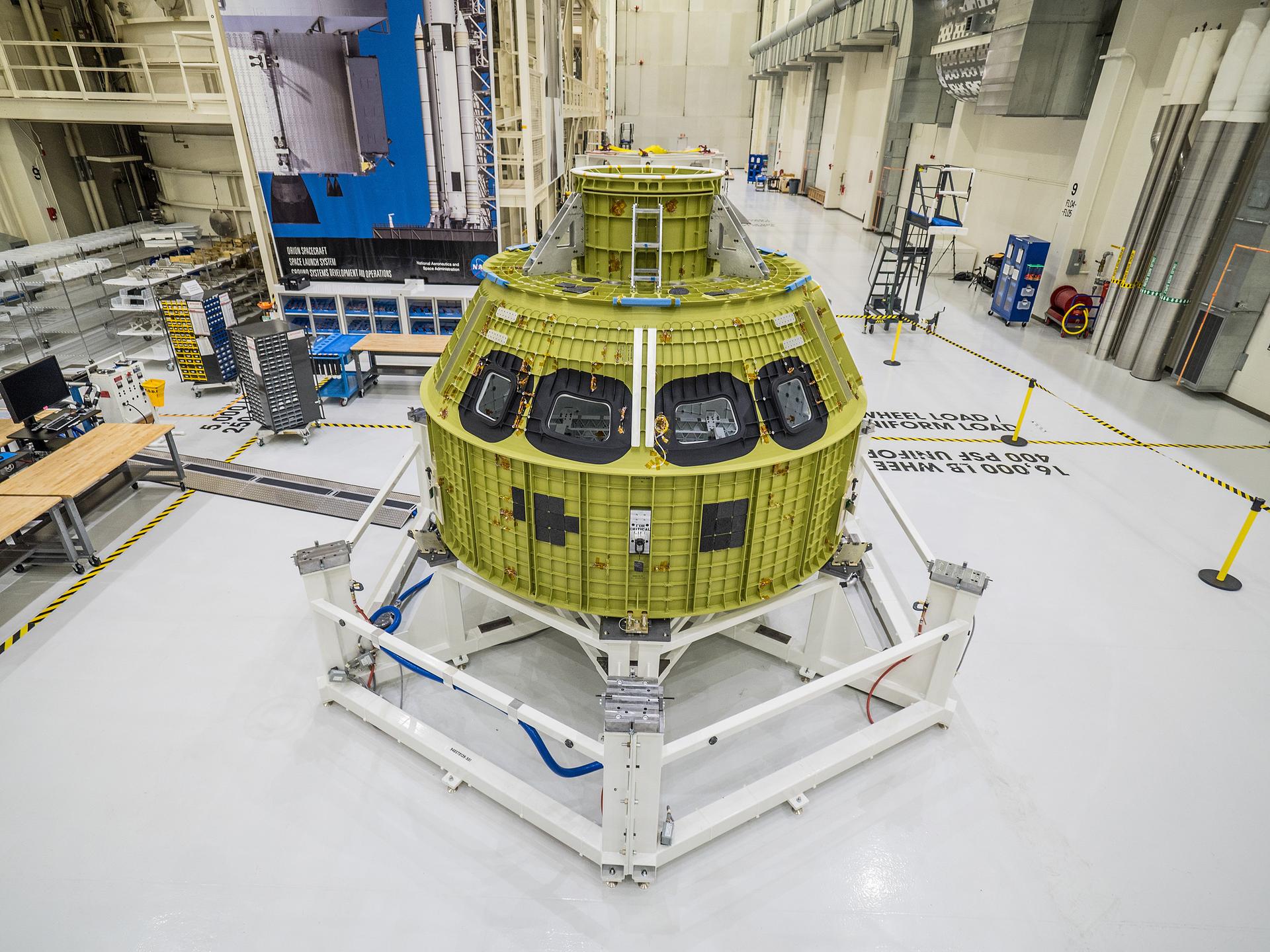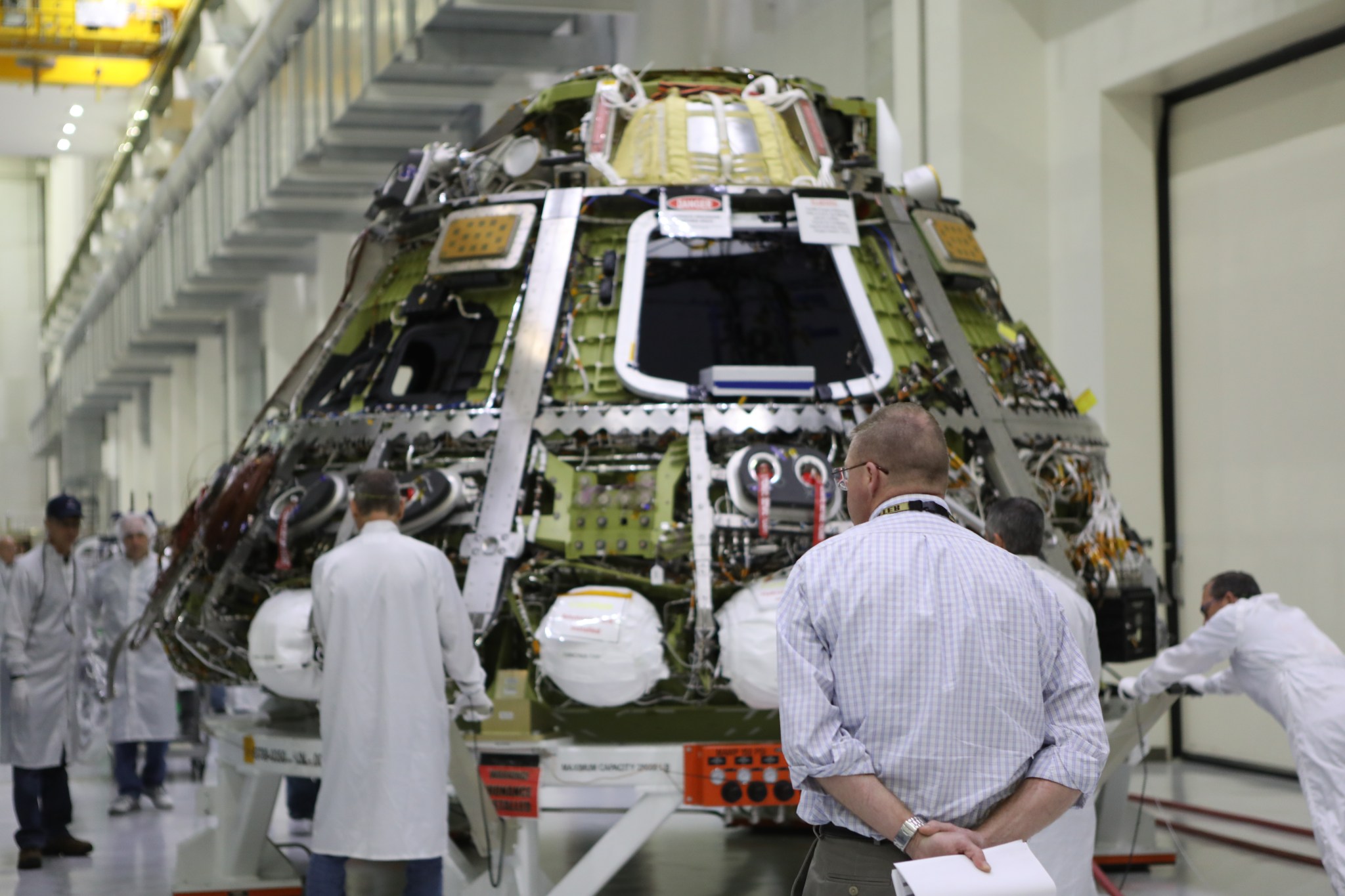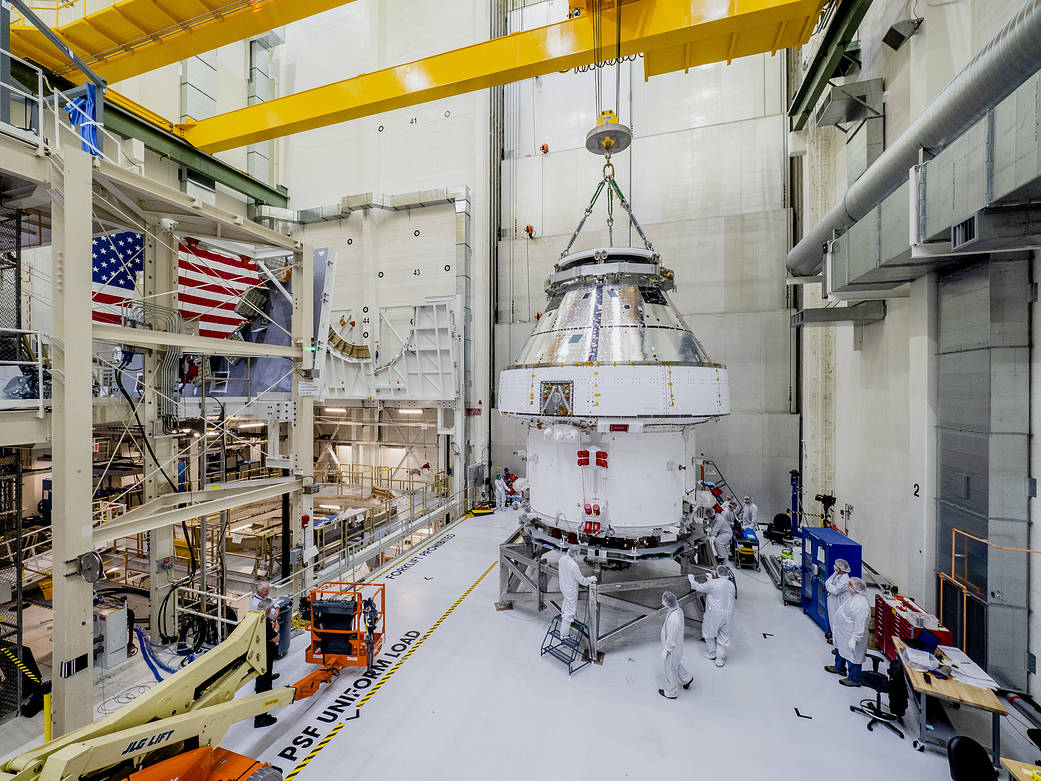Operations and Checkout Facility, Kennedy Space Center
The Neil Armstrong Operations & Checkout (O&C) Building at Kennedy Space Center in Cape Canaveral, Florida, has played a vital role in NASA’s spaceflight history. Built in 1964, the facility was used during the Apollo program to process and test the command, service, and lunar modules. The facility is being used today to process and assemble the Orion spacecraft. Orion is tested, assembled, and readied in a large room in the O&C called a high bay, operated by Lockheed Martin, that functions as a high-tech factory. The high bay includes unique tooling stations, test fixtures, chambers, and clean rooms for the buildup and testing of Orion.

Environmental Testing
Environmental testing, including thermal cycle testing and acoustic testing, takes place in the high bay of the O&C. Environmental testing is performed to simulate environments the spacecraft will experience through launch, travel in deep space, and recovery, as well as evaluate the spacecraft’s structure and systems in those conditions.
Crew and Service Module Direct Field Acoustic Testing
The crew module and service module undergo direct field acoustic testing separately to ensure they are prepared to endure the noises of launch and ascent to space. During this testing, the crew or service module is surrounded with speakers and exposed to maximum acoustic levels that the vehicle will experience in space. Engineers secure the module inside a test cell and then attach microphones, strain gauges, and accelerometers to it. The module is blasted with extreme vibrations and acoustic levels up to 141 decibels – as loud as a jet engine during takeoff – to ensure the spacecraft and its systems can withstand the noise expected during launch.
Crew Module and Service Module Thermal Cycle Testing
Thermal cycle testing is performed separately on the crew and service module inside a specially constructed thermal cycle chamber. Over several days, the crew or service module is rapidly cycled between hot and cold temperatures to thermally stress the hardware and ensure the workmanship of the module’s critical hardware and its subsystem operations.
Engineers successfully completed a thermal cycle test on the Artemis I crew module in February 2018. The cycle of temperatures for the initial thermal test ranged from 29 to 129 degrees Fahrenheit during 105 hours of testing. Engineers successfully completed a thermal cycle test on the Artemis I service module in December 2019.
Acceptance and Workmanship Testing
The Orion spacecraft undergoes assembly and testing in the high bay of the O&C Building to ensure its workmanship before ground processing and integration with the SLS rocket.
Proof Pressure Testing
Engineers conduct a series of tests on the spacecraft’s pressure vessel, or underlying structure of the crew module. In a test stand inside the proof pressure cell, technicians attach hundreds of strain gauges to the interior and exterior surfaces of the vehicle. The strain gauges measure the strength of the welds on the spacecraft as it is pressurized at incremental steps over two days to reach the maximum pressure it is expected to encounter during flight.
The tests confirm that the weld points of the underlying structure will contain and protect astronauts during the launch, in-space, entry into Earth’s atmosphere, and landing phases on Artemis missions.
Proof pressure testing was completed on the Artemis I pressure vessel in May 2016.
Crew Module and Service Module Functional and Performance Testing
Orion crew modules undergo initial power-on events, which are the first time the vehicle management computers and the power and data units are installed on the crew module, loaded with flight software and tested. These tests verify the health and status of Orion’s core computers and power and data units, and ensure the systems communicate precisely with one another to accurately route power and functional commands throughout the spacecraft.
Orion service modules also separately undergo initial power-on events. The initial power-on tests allow technicians to check all cables are connected and data is being transferred at the speeds required by Orion, as well as the power distribution across the module.
In August 2017, the Artemis I crew module was powered on for the first time. The Artemis I service module, integrated with the crew module adapter, was powered on for the first time in February 2019.
After initial power-on, the Orion crew module and service module undergo separate functional testing, which ensures each of the module’s systems powers on and functions as designed.
After functional testing is completed, separate performance testing of the crew module and service module takes place, which verifies that each module’s systems not only power on but are functioning at the correct parameters. Performance testing also takes place after the two modules are mated.
Spacecraft Integration and Final Testing
After functional and performance testing takes place on the crew and service modules individually, they are moved to the Final Assembly and System Testing (FAST) cell, where they are integrated and put through their final system tests prior to rolling out of the O&C for commodity servicing and integration with the rocket.
Inside the FAST cell, the integrated spacecraft goes through a final round of testing and assembly, including end-to-end performance verification of the vehicle’s subsystems, checking for leaks in the spacecraft’s propulsion systems, installing its solar array wings, performing spacecraft closeouts and pressurizing a subset of its tanks in preparation for flight prior to being transported to the Multi-Payload Processing Facility (MPPF). From July to November 2019, engineers at Kennedy mated the Artemis I crew and service module inside the FAST cell, where the integrated spacecraft underwent functional and performance testing.
The Artemis I spacecraft was then transferred to NASA’s Armstrong Test Facility in Sandusky, Ohio, where it underwent full environmental testing from December 2019 to March 2020.
The vehicle then returned to the FAST cell in March 2020, to go through a final round of testing and assembly prior to being transported to the MPPF in January 2021.



























